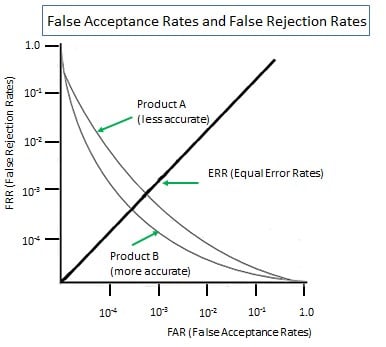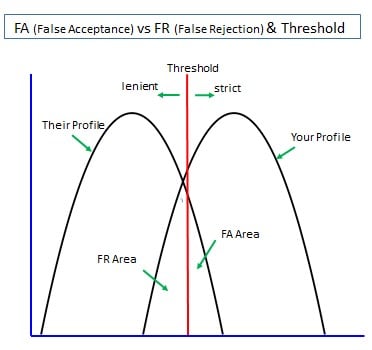In a mind-boggling report from India where the biometrics; is mandatory for its Aadhaar-based Public Distribution System, it says ‘biometric authentication failure at the ration shop deprived a woman of the subsidized grain she was entitled to’.
The report refers to ‘failure’ and ‘glitch’ of biometrics, but it is not necessarily correct. 'False Rejection' as against 'False Acceptance' is inherent in biometrics; there is no biometrics that is free from False Rejection.
A graph (*1) below shows the False Acceptance Rates (FAR) and False Rejection Rates (FRR) of two biometrics products - one relatively more accurate and the other less accurate.
What this graph indicates is, firstly, that FAR and FRR are not the variables that are independent from each other, but are dependent on each other.
A FAR could be fixed only against a certain FRR, i.e., both variables can be positioned only at the same single point on the same single curve. In other words, the couple of a FAR and a FRR can exist only in a certain combination.
Secondly, it also indicates that the lower a FAR is, the higher the corresponding FRR is. The lower a FRR, the higher the corresponding FAR. That is, FAR and FRR are not just mutually dependent but are in a trade-off relation
The level of a FAR that rejects a twin would have to bring the level of a FRR that rejects the registered user very frequently. The level of a FRR that eliminates the need of a fallback means would have to bring the level of a FAR that accepts nearly anyone.
Thirdly, also indicated is that the more accurate the biometrics sensor becomes (the lower the Equal Error Rate becomes), the curve goes downwards/leftwards in this graph. But, when a FAR is 0 (zero), the corresponding FRR still remains close to 1 (one). When a FRR is 0 (zero), the corresponding FAR remains close to 1 (one).
*1
*2
Another graph (*2) helps us to grasp how FAR and FRR are mutually dependent and also in a trade-off relation.
Move the threshold to the right (more strict) and we would see the combination of a lower FAR and a higher FRR. Moving it to the left (more lenient), the outcome would be the combination of a higher FAR and a lower FRR.
The presence of False Rejection, however close to 0 (zero) the rate might be, would require a fallback means against the False Rejection.
If the officials responsible for the Aadhaar-based PDS had been informed of the above, they must have provided a fallback means in case the false rejection. Then this kind of misery could have been avoided. We have to wonder how it was possible that these people were not advised of the issue of false rejection.
Hitoshi Kokumai
President, Mnemonic Security, Inc.
About Author
Hitoshi Kokuman is the inventor of Expanded Password System that enables people to make use of episodic image memories for intuitive and secure identity authentication. He has kept raising the issue of wrong usage of biometrics with passwords and the false sense of security it brings for 16 years.
Mnemonic Security Inc. was founded in 2001 by Hitoshi Kokumai for promoting Expanded Password System. "Mnemonic" and "Mneme" used in the company name and logo imply that our identity must be protected with our own memory and volition. Following the pilotscale operations in Japan, it is currently searching for the location to set up the global headquarters.
Related Article by this Author
Value Walk: Biometrics – Confused reports still circulating rampantly







